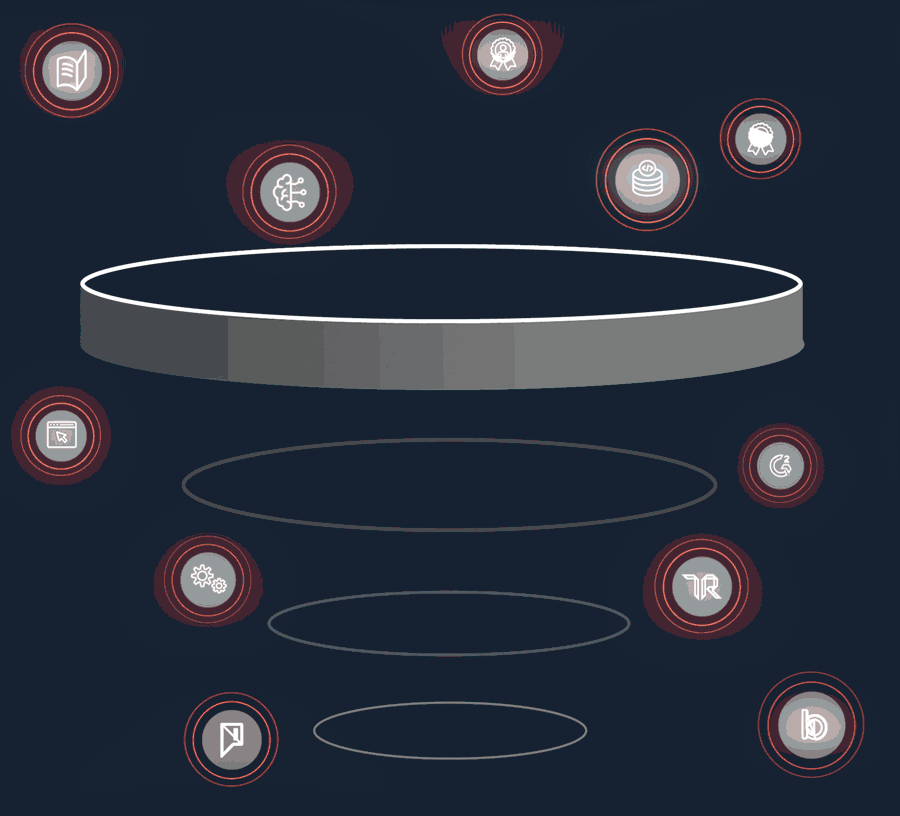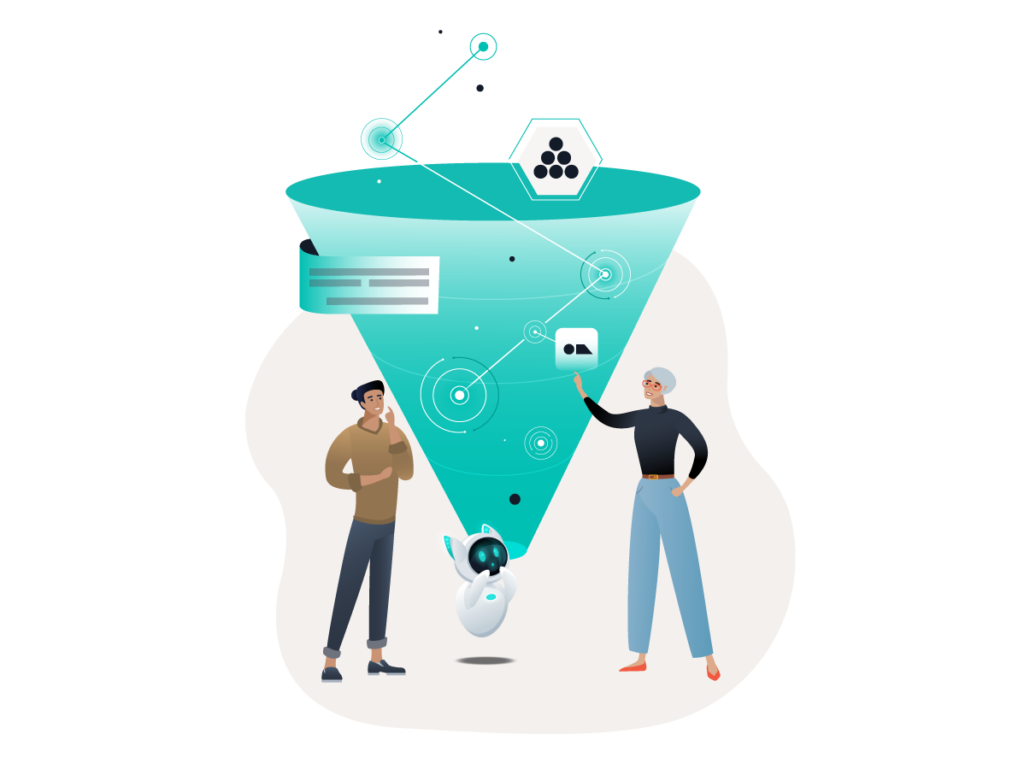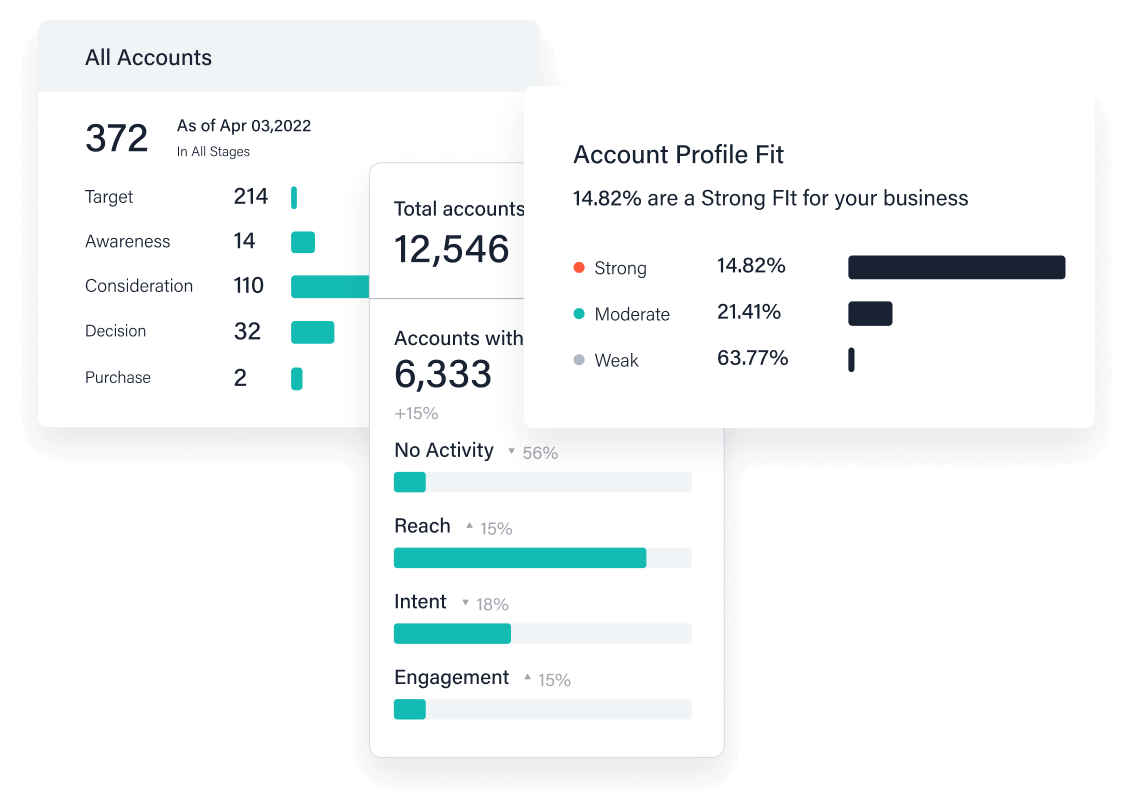• What is a B2B Marketing Funnel?; less than a minute
• B2B Marketing Funnel Stages; about 2 minutes
• How Do You Create a B2B Marketing Funnel; about 4 minutes
• Measuring and Optimizing the B2B Marketing Funnel; about 4 minutes
• Conclusion; less than a minute
Challenges for modern B2B marketers often include:
- Understanding the anonymized B2B web — aka the Dark Funnel™ — where B2B buyers conduct 70% of their research without ever speaking to your sales team
- Marketing to buying teams consisting of multiple stakeholders with unique interests and pain points
- Engaging in effective lead-nurturing and lead generation strategies for products with extended sales cycles while competing with a growing number of competitors
Digesting each of those challenges is essential. This is particularly true if you want to build an efficient B2B marketing funnel, in which each funnel stage must adapt to the nuances of the buyer’s journey to ensure seamless buyer progression and engagement.
This guide will:
- Break down the stages of the B2B marketing funnel
- Provide a step-by-step framework to create a marketing funnel, and
- Share actionable tips to ensure optimization and adaptability over the long term
Let’s begin!
What Is a B2B Marketing Funnel?
A B2B marketing funnel is a systematic method for guiding potential customers through the various stages of the customer journey.
However, it’s more than just a template for converting prospects into customers. It’s the foundation for tailoring strategies to align with your business objectives and the distinct preferences of your buyers.
Here are the core stages of a B2B marketing funnel:
- Top of the Funnel or Awareness Stage
- Middle of the Funnel or Interest/Consideration Stage
- Bottom of the Funnel or Decision/Action Stage

B2B Marketing Funnel Stages
Let’s examine each stage of the funnel and the distinct strategies you might use to move buyers from one stage to the next.
Top of the Funnel (TOFU): Awareness and Lead Generation
The top of the funnel (TOFU) stage aims to achieve market awareness of your offering. In other words, it’s all about assembling quality prospects for your marketing campaigns.
In the TOFU stage, your growth marketing strategy primarily revolves around creating educational content to build trust rather than sales-focused material.
For instance, if your business offerings include web design services, you can develop blog posts, infographics, guest posts, and educational videos that answer common questions your ideal customers might have about building e-commerce websites.
This educational content positions your brand as a valuable source of information, laying the groundwork for building lasting connections with potential clients.
Middle of the Funnel (MOFU): Interest and Lead Nurturing
The middle of the funnel (MOFU) stage cultivates audience interest in your products or services and in your brand as a whole.
The MOFU stage entails crafting and promoting content that imparts product-specific information. For reference, if you are crafting marketing strategies for a fintech company, then you should be developing in-depth product tutorials detailing the value-add of your firm’s tech offerings. The goal is to generate trust and engagement with leads. So, it’s still crucial to avoid overly sales-oriented content.
Continuing with the earlier example of a web design agency, you can create MOFU content by taking a question, such as “How to optimize website user experience,” and turning it into a comprehensive guide on how to enhance user engagement, implement intuitive navigation, and integrate visually appealing design elements.
In addition to guides, various content types are well-suited for the MOFU stage, including:
- Blogs
- Video tutorials
- Product reviews
- Whitepapers
- Landing pages
- Case studies
- Ebooks
- Email newsletters
Bottom of the Funnel (BOFU): Conversion and Customer Retention
In the bottom of the funnel (BOFU) stage, your primary goal is to convert your audience into paying customers and develop robust, long-term customer relationships.
BOFU marketing content is intentionally more sales-oriented and directed at prospects needing more information before deciding whether to buy from your company or a competitor.
For example, BOFU content might take the form of:
- Email sequences that effectively drive traffic to sales-centric landing pages
- Product demo videos that address your ideal client’s specific challenges and offer a guided tour of how your product or service provides potential solutions
- Case studies and testimonials that help illustrate the performance and overall appeal of your products or services
Beyond the conversion aspect, the BOFU stage also aims to build customer loyalty. Initiatives like promotional programs, such as credit rewards and referral discounts, contribute to retaining customers and encourage repeat business.
How Do You Create a B2B Marketing Funnel
Creating a well-structured and efficient B2B marketing funnel attracts and engages the right audience and guides them seamlessly through the entire customer journey. Here are the essential steps to create one for your business.
Step 1 – Identify and Define Your Ideal Customers
Begin by clearly defining your target customers. This process involves researching and understanding your ideal buyers’ key characteristics, pain points, and behaviors.
While many marketers excel at constructing Ideal Customer Profiles (ICPs), not every company that fits your ICP is ready to make a purchase. Some may lack interest, others might already be committed to contracts with competitors, and some could be constrained by budget limitations.

Rather than attempting to create a B2B funnel that appeals to all ICPs, a more efficient approach is to target accounts displaying buying signals. For example, If you are managing the marketing strategy for a wealth management company, this is where you want to scale your efforts around prospective customers who have already displayed a buyer’s interest in wealth management marketing services.
Tools that provide intent data, such as 6sense, can assist in identifying these in-market accounts, empowering you to concentrate your marketing efforts on In-Market Ideal Customer Profiles (IICPs) that are more likely to convert than traditional ICPs.
Step 2 – Map Content and Touchpoints for Each Funnel Stage
Next, develop a comprehensive content strategy that addresses your audience’s unique needs and questions at each stage—whether it’s TOFU, MOFU, or BOFU.
Map content pieces to specific touchpoints in the buyer’s journey, ensuring a seamless progression from one stage to the next.
TOFU
Start with creating blog posts and infographics for the TOFU stage, providing insightful industry overviews and visually engaging content.
Leveraging SEO strategies is also vital to ensure that your content is easily discoverable by those actively searching for related information.
Additionally, employing paid advertising on platforms like Google Ads or social media channels allows you to target specific demographics, ensuring your message reaches the right audience.
MOFU
As leads move into the MOFU stage, offer webinars and in-depth guides on specific topics related to your products or services.
Collecting a prospect’s contact information is also a common goal in the MOFU stage. However, it’s important to recognize that traditional contact forms often capture only a tiny fraction of a website’s unique visitors—about 3%.
Leveraging intent data with AI provides an alternative. By identifying and de-anonymizing account-level browsing activity, you can swiftly collect contact details for key company personas likely to be part of the buying team.
This method not only helps you sidestep the traditional form-based approach but also ensures a more seamless and user-friendly experience for your audience.
BOFU
In the BOFU stage, develop case studies and product-focused content that directly address your audience’s pain points and demonstrate the value of your offerings.
Direct outreach, especially to accounts in your IICP with multiple members of their buying team engaged in researching your brand, is also crucial at the BOFU stage. If you are coordinating the sales and marketing plans for an insurance company, this is when your company’s top sales representatives, or even executive team, should personally author tailored messages to prospective buyers.
6sense’s sales intelligence platform identifies these engaged accounts as 6sense Qualified Accounts (6QAs), signaling their importance to the entire revenue team.
Step 3 – Implement Marketing Automation and CRM Tools
Marketing automation and customer relationship management (CRM) tools enable you to create personalized, targeted campaigns based on user behavior and interactions.
Marketing automation helps nurture leads by delivering the right content at the right time, while CRM tools assist in managing customer relationships and tracking interactions throughout the funnel.
Integrating these technologies enhances efficiency, scalability, and the ability to deliver a consistent and tailored experience to your B2B audience.
Step 4 – Define Lead Scoring and Qualification Criteria
Next, establish a lead scoring system to prioritize and identify the readiness of leads to move through each stage of the funnel.
Lead scoring involves assigning scores to leads based on engagement levels, such as email opens, webinar attendance, or content downloads. For instance, assign higher scores to leads who consistently engage with your content or attend multiple webinars, indicating a stronger interest and readiness for progression.

In addition to lead scoring, implementing lead qualification criteria ensures that your sales team focuses their efforts on leads most likely to convert.
Incorporate intent data that helps identify In-Market Ideal Customer Profiles (IICPs) by analyzing active research and engagement signals.
Step 5 – Establish Tracking and Analytics Mechanisms
To measure the success of your efforts leverage tools like Google Analytics and marketing automation analytics to measure key marketing metrics at each stage of your funnel.
Schedule time to regularly analyze the data to identify areas for improvement and refinement. For example, you may set a reminder in your calendar to conduct a bi-weekly or monthly review of your analytics dashboard.
During these reviews, focus on evaluating the performance of each funnel stage, identifying drop-off points, and understanding user behavior.
Measuring and Optimizing the B2B Marketing Funnel
Measuring and optimizing the B2B marketing funnel is a dynamic process that requires a sharp understanding of key performance indicators (KPIs) and the potential challenges posed by the Dark Funnel™.
Focus on the Next-Gen Marketing Metrics
Optimizing your B2B marketing funnel requires a nuanced approach to key metrics. Traditional indicators like conversion rates and acquisition costs offer some insights, but we also recommend paying attention to next-gen marketing metrics to level up your optimization strategies.
For instance, a low conversion rate at the middle of the funnel (MOFU) may indicate a need for more engaging content or personalized nurturing strategies. However, shifting the focus to metrics like view-through rates or the number of accounts engaged within the MOFU stage can provide a more nuanced understanding of how well your audience actively engages with your brand.
This shift in perspective allows for a more strategic allocation of resources and budget toward actions directly aligned with desired outcomes at each stage of your funnel.
The Dark Funnel™ and Its Implications
The Dark Funnel™ refers to the hidden online spaces where potential B2B buyers conduct research without leaving identifiable traces or ever talking to your sales team.
According to recent data, 70% of today’s buying process takes place in the Dark Funnel™. Let’s illustrate what that looks like with the following example:
A prospect starts by searching keywords and topics related to their problems. They then scour review platforms like G2 to find vendors and solutions.
After shortlisting a few potential solutions, they might watch a few product reviews on YouTube. They may even submit a question on Reddit to see what other professionals in their industry recommend. Finally, a few weeks or months later, they might arrive at your website, skim a case study, and book a demo with your sales team.
On top of that, your ideal buyer is more likely to be a buying team consisting of eleven members on average rather than an individual decision-maker. Each member may research to see how your offer can provide solutions to their unique problems.
You see how these covert actions within the Dark Funnel™ create a substantial obstacle for B2B marketing? It prevents you from fully understanding your buyer’s journey and accurately attributing conversions to specific touchpoints in your funnel.
So, what can you do to ensure your B2B marketing funnel remains adaptable and responsive?
Strategies for Overcoming the Dark Funnel™
By incorporating the following strategies, you can adapt to the challenges posed by the Dark Funnel™ and transform them into opportunities for more personalized engagement.
Implement Advanced Data Matching
Also make sure to leverage advanced data-matching techniques. This approach allows for a more nuanced understanding of anonymous data, increasing the chances of accurate connections to known accounts.
For example, imagine a scenario where a prospect anonymously explores your product on external industry forums. Advanced data matching can help identify this behavior, allowing you to tailor your content and engagement strategies to address the prospect’s specific needs.
Leverage Account Engagement Platforms
Employ sophisticated account engagement platforms, such as 6sense, equipped with integrated Customer Data Platforms (CDPs).
These platforms act as comprehensive repositories of business account information, merging data from various sources to make anonymous signals identifiable.
For instance, when a prospect from an unknown account exhibits specific behaviors on your website, the CDP can consolidate this data, revealing patterns that help identify the account. This identification enables more personalized interactions and targeted content delivery.
The chosen platform should follow privacy-compliant practices in managing and organizing data. This ensures the ethical and secure handling of sensitive information, fostering trust with your audience and aligning with data protection regulations.
Embrace Predictive Analytics
By analyzing buying journey durations, team sizes, and the preferred information sources of buying teams, you can tailor your marketing strategies to align with observed behaviors.
For example, predictive analytics may reveal that buying teams in your industry tend to engage in prolonged research phases before making decisions.

With this knowledge, you can develop content and engagement strategies that accommodate and support this extended decision-making process.
Tap into Buyer Readiness Signals
Explore specialized insights such as market intelligence signals, technographic signals, and psychographic signals.
These signals provide a deeper understanding of internal company dynamics, technological infrastructures, and the interests of the buying organization, enabling more personalized and targeted marketing efforts.
For example, suppose the market intelligence signal indicates a shift in the industry’s technology preferences. In that case, you can proactively adjust your messaging to align with these changes, ensuring that your content remains relevant and resonates with your audience’s evolving needs.
Conclusion
Strategic planning of the B2B marketing funnel is crucial for modern marketers, especially while facing the challenges posed by the Dark Funnel™. Each funnel stage also requires a tailored approach to engage buyers seamlessly and drive conversions.
We encourage you to apply the insights from this guide to your B2B marketing efforts, ensuring your strategies align with the nuanced behaviors of your target audience.
To take these strategies to the next level, book a demo of 6Sense.
Our team will show you how to unlock the power of intent data and optimize your funnel for personalized, informed, and effective engagement!



